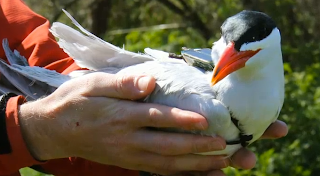We are approaching 10 years of studying the mass
migration of freshwater fishes from Lake Krankesjön into the connecting
streams! Nearly time for some kind of party…
The old antenna system has served us well, but
recent support from CAnMove and Fysiografen has enabled us to modernise. To
study fish migration we use passive telemetry, collecting data on the movements
of tagged individuals with continuously operating antenna stations in every
stream. Last year we installed a brand new and upgraded system, which required
a new database to handle the millions of data points generated by the seasonal
movements of mostly cyprinid fishes. We hosted Dr. Henrik Baktoft of the Danish
Technical University, who, along with CAnMove’s Johan Bäckman, built a
custom-made database to hold old data and process new information gathered by
the system.
 Fysiografen also funded the project 170 ksek to
modernise the system further. We will install solar panels at the remote
antenna stations so that our migration research will have a self-supporting
energy supply. In addition we will install technology that allow us to send the
data from our study site straight to Lund via mobile phone satellites and into
the database on a daily basis. This will save us time and also make the project
a great deal more environmentally friendly!
Fysiografen also funded the project 170 ksek to
modernise the system further. We will install solar panels at the remote
antenna stations so that our migration research will have a self-supporting
energy supply. In addition we will install technology that allow us to send the
data from our study site straight to Lund via mobile phone satellites and into
the database on a daily basis. This will save us time and also make the project
a great deal more environmentally friendly!
Our aim is to have (almost) real time data from
the fish migration available on the CAnMove webpage, so that fellow migration
enthusiasts can follow the fish as they migrate. This advanced and upgraded
system will also support us in our current projects, which include investigating
sex differences in migratory behavior, experimentally manipulating predation
risk to assess migratory plasticity, evaluating the impact of pollutants upon
migration and searching for the mechanisms of navigating during migration. It
will also help us develop a longer-term project, which aims to quantify some of
the costs and benefits associated with migratory versus resident strategies.
The future is bright! Thanks to CAnMove and Fysiografen for their support!
//Kaj, Ben, Christer B & Lars-Anders
 The course has been given since 1999, with CAnMove as sole organizer since 2009. Last time the course attracted students from 17 different countries!
The course has been given since 1999, with CAnMove as sole organizer since 2009. Last time the course attracted students from 17 different countries!







